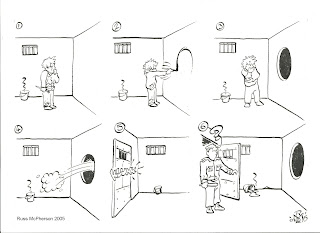Often overshadowed by his famous mother Violeta, one of the leading influences who helped shape the sound of the Chilean Nueva Cancion (New Song) movement, Angel Parra's life is in many ways just as interesting, taking him far beyond Chile.
His exile was originally involuntary. Due to his left-wing political ideals and his links with the Popular Unity party of Salvador Allende, after the 11th of September 1973 coup d'état (documented by Cuban film-maker Santiago Alvarez in his film The Tiger Leaps and Kills, but it will Die...it will Die) Parra was initially held at the National Stadium, before being transferred to the Chacabuco prison camp, where he was kept until February 1974.
He used his time
there to help set up a committee to organize cultural activities for
the prisoners. Before being released, Parra sang to the rest of his inmates, in a performance that was
recorded covertly by Luis Corvalán and released in 1975 on an album
titled Chacabuco. It was also during his time in prison that he wrote "La
pasión según San Juan, Oratorio de Navidad" (The passion according to San Juan) which was eventually recorded
and published in Europe.
After his release, he fled first to Mexico to avoid further persecution, before moving to France, which was at that time home to the largest worker's party in western Europe, the Parti communiste français (PCF). It was here that, in
addition to being able to record and release his music again, he shared his testimony about the human rights
violations he suffered under the US-backed military
dictatorship.
One of the first
albums he recorded after settling in France was Angel Parra a
Paris, which was originally released in 1978 as a double LP,
being Angel's most extensive production to date. Most of the songs
are composed by Parra himself, some of them drawn from previous albums and combined with studio versions of songs previously
only recorded live. There are also some cover versions of songs by his mother Violeta Parra
as well as others composed by people like the Cuban troubadour Carlos Puebla. Other albums Parra released around this period are the Chilean popular guitar album La prochain fois (The next time) along with the last album he recorded with his sister Isabel in 1981.
Also in 1978 he
made a small cameo appearance in El Cantor (The Singer), a TV movie produced in
the GDR (East Germany) inspired by the life of his colleague, the murdered Chilean
singer-songwriter Victor Jara. The film was written and directed by
the US-born actor and singer Dean Reed (who played Jara in the film) who,
like Parra himself, had known Jara in Chile before his murder.
With the successful referendum to restore democracy, Parra returned to
Chile in 1989, and during the 1990s he began to see some of his albums reissued in his birth country. However, he continued to
make his home in Paris, where he eventually died of cancer in 2017. He is buried
in Pere Lachaise, along with other famous exiles like Jim Morrison
and Oscar Wilde.
You can buy one of my renditions of Parra, this one in pen and ink, from my Red Bubble shop here.




